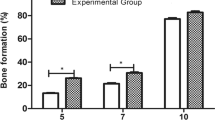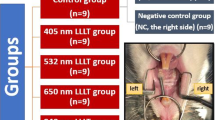Abstract
Low-level laser has been indicated to have the capability to facilitate the differentiation of the osteoclastic and osteoblastic cells which are responsible for the bone remodeling process. The aim of this study was to evaluate the effects of InGaAlP laser with a wavelength of 660 nm on the rate of tooth movement and histological status. Thirty male Wistar rats of 7 weeks old were selected for this study. The rats were randomly divided into two groups of 15 each to form the experimental (laser-irradiated) and control (non-irradiated) groups. The control group received unilateral orthodontic appliance design (one quadrant), but the laser-irradiated group received split-mouth design, with orthodontic appliance on both sides and laser irradiation on one side only (group b) and on the contralateral side (group c). The orthodontic appliance consisted of a NiTi closed coil spring with a length of 5 mm which was ligated to maxillary molar and incisor. A total of 60 g of force was applied to the rat molar. The diode laser (660 nm) was irradiated with an output power of 25 mW in continuous mode for a total time of 5 min in the laser-irradiated group. After 14 days of orthodontic tooth movement, the amount of tooth movements was measured. In the laser-irradiated group, the amount of tooth movement was significantly greater than that of the non-irradiated group (2.3-fold), but there was no significant difference between the non-irradiated and indirectly irradiated groups. Histopathological studies revealed that the number of osteoclasts in the laser-irradiated group was significantly greater than that of the non-irradiated group (1.5-fold) while this number was almost the same in the non-irradiated and indirectly irradiated groups. The results suggested that low-level laser can accelerate the rate of bone remodeling. However, in order to utilize the low-level laser as an adjunct in orthodontic practice on patients, further research studies are needed for finding the appropriate dosage for the human tissues.




Similar content being viewed by others
References
Proffit WR (2013) Mechanical principles in orthodontic force control. In: Proffit WR, Fields HW, Sarver DM (eds) Contemporary orthodontics, 5th edn. Mosby, St. Louis
Robers EW (2012) Bone physiology, metabolism, and biomechanics in orthodontic practice. In: Graber LW, Vanarsdall RL, Vig KWL (eds) Orthodontics: current principles and techniques, 5th edn. Mosby, St. Louis
Davidovitch Z, Finkelson MD, Steigman S, Shanfeld JL, Montgomery PC, Korostoff E (1980) Electric currents, bone remodeling, and orthodontic tooth movement. I. The effect of electric currents on periodontal cyclic nucleotides. Am J Orthod 77(1):14–32
Davidovitch Z, Finkelson MD, Steigman S, Shanfeld JL, Montgomery PC, Korostoff E (1980) Electric currents, bone remodeling, and orthodontic tooth movement. II. Increase in rate of tooth movement and periodontal cyclic nucleotide levels by combined force and electric current. Am J Orthod 77(1):33–47
Davidovitch Z, Nicolay OF, Ngan PW, Shanfeld JL (1998) Neurotransmitters, cytokines and the control of alveolar bone remodeling in orthodontics. Dent Clin North Am 32(3):411–435
Turnér J, Lars Hode (2007) The new laser therapy handbook. Prima Books, Grängesberg. ISPN 91 – 631–1345 – 7
Coombe AR, Ho CT, Darendeliler MA, Hunter N, Philips JR, Chapple CC, Yum LW (2001) The effects of low level laser irradiation on osteoblastic cells. Clin Orthod Res 4(1):3–14
Stein A, Benayahu D, Maltz L, Oron U (2005) Low-level laser irradiation promotes proliferation and differentiation of human osteoblasts in vitro. Photomed Laser Surg 23(2):161–166
Nicola RA, Jorgetti V, Rigau J, Pacheco MT, dos Reis LM, Zângaro RA (2003) Effect of low-power GaAlAs laser (660 nm) on bone structure and cell activity: an experimental animal study. Lasers Med Sci 18(2):89–94
Saito S, Shimizu N (1997) Stimulatory effects of low-power laser irradiation on bone regeneration in midpalatal suture during expansion in the rat. Am J Orthod Dentofac Orthop 111(5):525–532
Limpanichkul W, Godfrey K, Srisuk N, Rattanayatikul C (2006) Effects of low-level laser therapy on the rate of orthodontic tooth movement. Orthod Craniofac Res 9(1):38–43
Cruz DR, Kohara EK, Ribeiro MS, Wetter NU (2004) Effects of low-intensity laser therapy on the orthodontic movement velocity of human teeth: a preliminary study. Lasers Surg Med 35(2):117–120
Youssef M, Ashkar S, Hamade E, Gutknecht N, Lampert F, Mir M (2008) The effect of low-level laser therapy during orthodontic movement: a preliminary study. Lasers Med Sci 23(1):27–33
Kim YD, Kim SS, Kim SJ, Kwon DW, Jeon ES, Son WS (2010) Low-level laser irradiation facilitates fibronectin and collagen type I turnover during tooth movement in rats. Lasers Med Sci 25(1):25–31
Fekrazad R, Chiniforush N, Bouraima SA, Valipour M, Aslani M, Zare M, Ashtiani Safari O (2012) Low level laser therapy in management of complications after intra oral surgeries. J Lasers Med Sci 3(4):135–140
Mohkovska T, Mayberry J (2005) It is time to test low level laser therapy in Great Britain. Postgrad Med J 81(957):436–441
Sun G, Tuner J (2004) Low-level laser therapy in dentistry. Dent Clin N Am 48(4):1061–1076
Grigoriadis AE, Kennedy M, Bozec A, Brunton F, Stenbeck G, Park I, Wagner EF, Keller GM (2010) Directed differentiation of hematopoietic precursors and functional osteoclasts from human ES and iPS cells. Blood 115(14):2769–2776
Xing L, Schwarz EM, Boyce BF (2005) Osteoclast precursors, RANKL/RANK, and immunology. Immunol Rev 208:19–29
Verna C, Dalstra M, Melsen B (2000) The rate and the type of orthodontic tooth movement is influenced by bone turnover in a rat model. Eur J Orthod 22:343–352
Petri AD, Teixeira LN, Crippa GE, Beloti MM, de Oliveira PT, Rosa AL (2010) Effects of low-level laser therapy on human osteoblastic cells grown on titanium. Braz Dent J 21(6):491–498
Yaakobi T, Maltz L, Oron U (1996) Promotion of bone repair in the cortical bone of the tibia in rats by low energy laser (He-Ne) irradiation. Calcif Tissue Int 59:297–300
Kawasaki K, Shimizu N (2000) Effects of low-energy laser Irradiation on bone remodeling during experimental tooth movement in rats. Lasers Surg Med 26(3):282–291
Kim YD, Kim SS, Kim TG, Kim GC, Park SB, Son WS (2007) Effect of low level laser treatment during tooth movement-immunohistochemical study of RANKL, RANK, OPG: an experimental study in rats. Laser Phys Lett 4:616–623. doi:10.1002/lapl
Seifi M, Shafeei HA, Daneshdoost S, Mir M (2007) Effects of two types of low-level laser wave lengths (850 and 630 nm) on the orthodontic tooth movements in rabbits. Lasers Med Sci 22(4):261–264
Fujita S, Yamaguchi M, Utsunomiya T, Yamamoto H, Kasai K (2008) Low-energy laser stimulates tooth movement velocity via expression of RANK and RANKL. Orthod Craniofac Res 11(3):143–155
Marquezan M, Bolognese AM, Araújo MT (2010) Effects of two low-intensity laser therapy protocols on experimental tooth movement. Photomed Laser Surg 28(6):757–762
Habib FA, Gama SK, Ramalho LM, Cangussú MC, Santos Neto FP, Lacerda JA, Araújo TM, Pinheiro AL (2010) Laser-induced alveolar bone changes during orthodontic movement: a histological study on rodents. Photomed Laser Surg 28(6):823–830
Krishnana V, Davidovitchb Z (2006) Cellular, molecular, and tissue-level reactions to orthodontic force. Am J Orthod Dentofac Orthop 129:469e.1–469e.32
Ren Y, Maltha JC, Kuijpers-Jagtman AM (2004) The rat as a model for orthodontic tooth movement. Eur J Orthod 26:483–490
Milne TJ, Ichim I, Patel B, McNaughton A, Meikle MC (2009) Induction of osteopenia during experimental tooth movement in the rat: alveolar bone remodelling and the mechanostat theory. Eur J Orthod 31(3):221–231
Author information
Authors and Affiliations
Corresponding author
Rights and permissions
About this article
Cite this article
Shirazi, M., Ahmad Akhoundi, M.S., Javadi, E. et al. The effects of diode laser (660 nm) on the rate of tooth movements: an animal study. Lasers Med Sci 30, 713–718 (2015). https://doi.org/10.1007/s10103-013-1407-1
Received:
Accepted:
Published:
Issue Date:
DOI: https://doi.org/10.1007/s10103-013-1407-1




